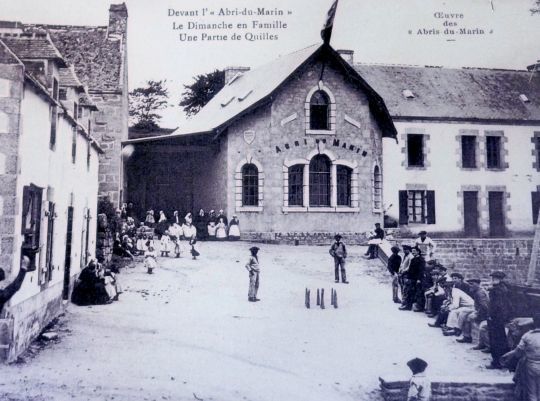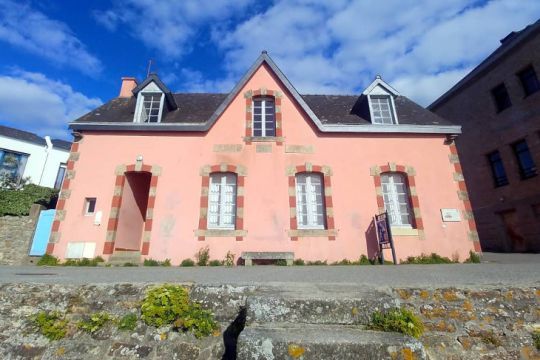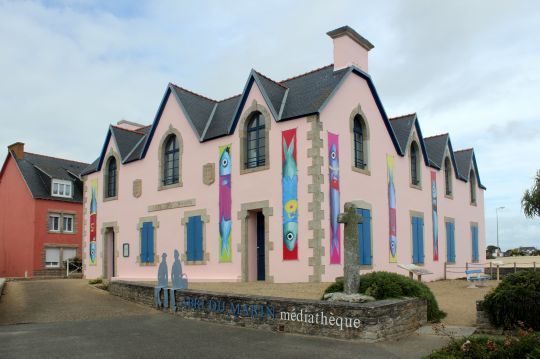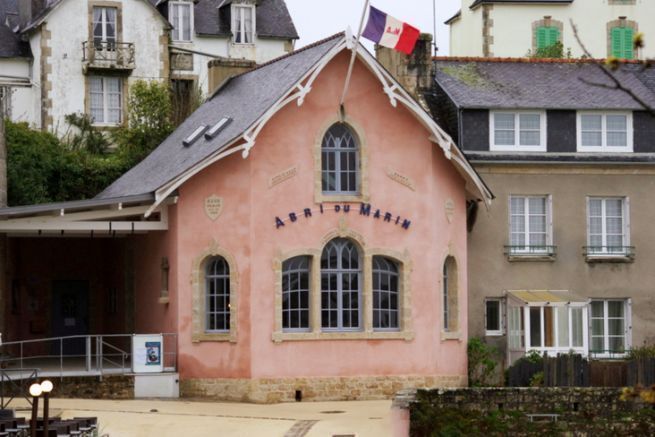Raise awareness of the difficult living conditions of fishermen
In 1888, Jacques de Thézac (1862-1936), a wealthy man with a passion for sailing, settled in Sainte-Marine, a charming little port in Finistère. While sailing along the coast, he discovered the harsh living conditions of the fishermen, who often had no choice but to take shelter in taverns during their stopovers. He decided to offer them better living conditions, while fighting against alcoholism.
At first, he spread through the Almanach du Marin Breton euros, the first copy of which appeared in 1889, pictures of scenes of life of fishermen and their families. But these did not have enough impact. Their diffusion will nevertheless finance in part the opening of the future shelters.
Build shelters to protect fishermen
He then decided to launch the construction "healthy, well-heated, comfortably appointed places." These buildings, called the Sailor's Shelter, are inspired by the British Sailor's home and the sailors' houses of the big commercial ports.
A "test" shelter was created in 1899 on the island of Sein and was an immediate success. An association was then created in 1904, composed of professionals from the maritime world (skippers, fishermen, canners), artists and men of letters. It was recognized as a public utility in 1920 and subsidized by the Ministry of the Navy and the General Council of Finistère.
The first Sailor's Shelter was built in March 1900 in Guilvineceuros; the last one was built in Saint-Guénolé in 1952. From 1900 to 1933, 12 shelters were created : 11 in Finistère, mainly in the busy ports of Cornouaille, and 1 in Morbihan. In 1952, there were 15 Mariners' shelters from Roscoff (1910), in the North, to Palais (1901), the southernmost shelter. 5 other shelters were almost built (Le Conquet, Tréboul, Port-Manec'h, Locmiquelic and Etel) but the project was abandoned.

Seafarer's shelter, living space and training centers
Each establishment is managed locally by a committee of about 20 sailors, elected by their comrades. A euro fisherman, who lives with his family in the euro shelter, is in charge of enforcing the internal rules and ensuring a good atmosphere.
The Marin shelters are used for multiple activities. True living spaces, they served as shelters as well as health care centers (they were equipped with a pharmacy as early as 1906). They housed cabarets where only water and herbal teas were consumed, and game rooms decorated with nautical charts, photographs of Jacques de Thézac and Christian and patriotic symbols. There was also a reading room (practical books and travel stories), a conference room to fight against alcoholism, an apprenticeship and training center for the fishing industry, a boat and sail repair workshop, and places to practice gymnastics (often the courtyard for the last two activities).
A strong post-war activity
During the Second World War, the society was recognized as a "Navy social work" and offered care to the wounded. The shelters were very popular during this period, and after the war, three new buildings were built: Port-Maria (Quiberon) in 1946, Houat in 1950 and Saint-Guénolé in 1952.
That same year, the social works were grouped together by the Comité Central des Pêches, which signaled the decline of the Abris du Marin. The living conditions of the fishermen had improved and the establishments were gradually deserted. In 1973, only three establishments kept a decent activity: Sainte-Marine, Le Guilvinec and Poulgoazec.

Simple and quite similar constructions
The Sailor's Shelters are simple constructions, whose architecture was inspired, until 1910, by the first shelter built in Guilvinec in 1900. It is an elongated building on a single level, the first floor being composed of unfinished attics, overhung by a dormer-gable on the roof of the main facade and decorated with a covered courtyard on the rear facade. The buildings are built in rendered rubble stone - the enclaves are in granite - then painted pink to be easily identified from the harbor. No plans of the different buildings have been preserved.

Two shelters stand out for their neo-Gothic architectural plans and styles: Sainte-Marine and Douarnenez, both recognized as historic monuments in 2007 and built in the early 1910s. It is possible that they were built by the same architect. From this date, the facades of the shelters of the Sailor are adorned with evangelical quotations and morals written in French and Breton.
All the shelters were sold after the war, notably to private individuals. Only two shelters, Poulgoazec (1933) and Saint-Guénolé (1952), have kept their maritime vocation. The first one is the meeting place of the local fisheries committee and the second one is the headquarters of the Crédit Maritime. Some of the others have kept their cultural or reception vocation, like Le Guilvinec, which today hosts the communal media library - the building having been raised in 1924 - or Lanriec which has become a municipal hall.

Shelters recognized as historical monuments
Several former "Abris du Marin" have been recognized as historical monuments in 2007. Those of the island of Sein, but also the two buildings of Sainte-Marine and Douarnenez of Gothic inspiration, whose architecture differentiates them from the others.
The Abri de Sein was built in December 1900, on the same architectural model as the first one in Guilvinec (March 1900). Located on the Men Brial point, it welcomed fishermen from Cap-Sizun, Douarnenez, Camaret, and even Paimpol, for the shellfish that the Chaussée de Sein was full of. Very busy, it quickly became too small. A second building was then added in 1906, housing two large playrooms, a workshop for repairing and treating sails and accommodation for the keeper's family. The first building was then dedicated to the library. It has now become a private home. The 1906 building was bought by the municipality in 1974 and became the Musée des Sénans.
The shelter of Sainte-Marine was inaugurated on October 23, 1910. It welcomes the fishermen of the port, who specialized in lobster. This building is directly integrated into the place of residence of Jacques de Thézac, described as "a model shelter, original and charming." It stands out from the others by its architectural elegance and neo-Gothic inspiration.
In 1900, Douarnenez was the most important sardine port in the area: 5,600 fishermen and 26 canneries. The Abri du Marin was built on the point of Rosmeur in 1912, but was immediately requisitioned by the army to serve as barracks. The fishermen found their building in 1917. Very popular until after the Second World War, it is the most imposing construction of all the shelters. Its architecture was inspired by that of Sainte-Marine.
List of Marine Shelters
- Le Guilvinec (1900)
- Sein (1900)
- Audierne (1901)
- Concarneau (1901)
- Lanriec (1901)
- Camaret (1903)
- Sainte-Marine (1904)
- Tréboul (1906)
- Tudy Island (1908)
- Roscoff (1910)
- Douarnenez (1914)
- Poulgouzec (1933)
- Port-Maria (1946)
- Houat (1950)
- Saint-Guénolé (1952)

 /
/ 







